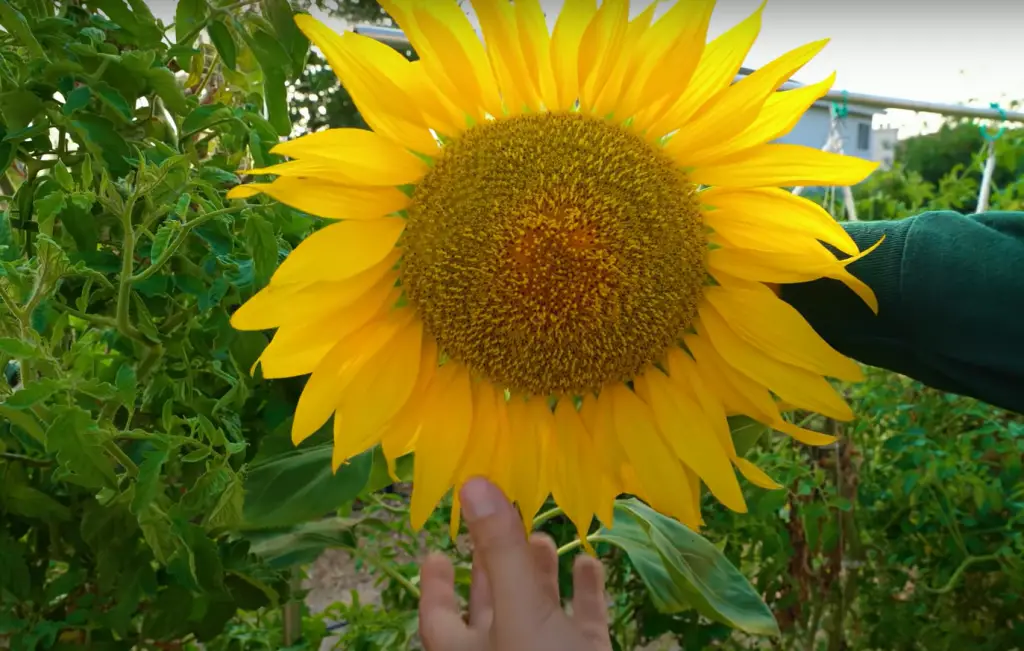When you think of gorgeous, cheerful-looking blooms in the summertime, many people likely picture sunflowers dancing in the sunshine. These vibrant and hardy flowers are quite popular due to their tall stature and easy to care for nature, but what about transplanting them? Can sunflower plants be moved from one spot to another or do they prefer to stay where they’re planted? It turns out that the answer is a little more complicated than it seems. In this article we will explore all elements related to growing and harvesting sunflowers, delving into whether or not these large blooms can indeed be transplanted. We’ll also look at some interesting facts about these amazing plants so you can better understand everything there is to know about caring for them!
What is the Specialty of Growing Sunflowers?
Sunflowers are one of the most popular flowers to grow in gardens because of their vibrant colors, sizes, and shapes. They come in a wide variety of colors from yellow and orange to dark reds and purples. Sunflowers also have a long bloom time that can last up to eight weeks at times.
One of the main appeals to growing sunflowers is their ability to bring in pollinators like bees, butterflies, birds, and other beneficial insects into your garden. By adding sunflowers you will help support biodiversity in your area as these pollinators move from flower to flower collecting nectar. Sunflowers also require very little water and fertilizer, which makes them ideal for gardeners who are trying to conserve resources. [1]

Sunflowers can be planted in large or small areas depending on the space you have available and they do best when planted near a south-facing wall so that they get plenty of sunshine throughout the day. Growing multiple types of sunflowers will help ensure that your garden is always full of blooms from spring through fall. Planting different colors and sizes of sunflowers together will create a beautiful contrast that will draw the attention of everyone who visits your garden.
Overall, growing sunflowers is an easy and fun way to bring some brightness into your garden. With their vibrant colors and long bloom time, sunflowers are sure to be a highlight of any outdoor space. Plus, with the added benefits of attracting pollinators and being low-maintenance, it’s easy to see why these flowers have become so popular in recent years. So if you’re looking for an easy way to spruce up your garden this year, consider including some beautiful sunflowers! [2]
What Kind of Production Uses Sunflowers?
- Sunflower oil is widely used in the food industry, especially for frying and baking. It is also used as a flavor enhancer in many snacks.
- The seeds are used to make sunflower butter or as a snack on their own.
- Sunflowers can be pressed into an oil that is used as fuel for biodiesel engines.
- Animal feed often contains ground sunflower seeds due to its high protein content and palatability.
- Landscaping uses include growing sunflowers in gardens and using them for decoration at events or weddings.
- The petals of some varieties of sunflowers can be made into dyes and pigments, adding color to fabrics and other materials.
- Some varieties of sunflower are used in the production of rubber.
- Sunflowers can also be used as a cover crop, helping to reduce soil erosion and add organic matter to poor soils.
- Many beauty products use sunflower oil for its moisturizing properties. It is sometimes combined with other essential oils or fragrances for a pleasant smell and added therapeutic benefits.
- Finally, sunflowers make great natural decorations in homes and offices, bringing cheer and color wherever they go. [3]
What Does Transplanting Sunflowers Mean?
Transplanting sunflowers is the process of moving a young sunflower plant to a new location. This is often done when the plant has outgrown its pot or needs to be moved for some other reason, such as away from direct sunlight or too much wind. Transplanting should be done carefully and with consideration for the plants’ needs in order to ensure its continued health and provide it with the best growing conditions possible.

When transplanting sunflowers, you must first check that there are no pests on the plant before beginning the process. Then, gently remove it from its old container by loosening any roots that have become wrapped around themselves or stuck in crevices of the potting soil. Once freed, place the sunflower into its new home in a way that it is firmly rooted and supported. Fill around the root ball with fresh potting soil, then water thoroughly to help settle everything in and add some more soil if necessary. You should also prune away any dead or damaged stems and leaves. [4]
Tending to your sunflowers after transplanting them is important for their continued health. Be sure to keep them watered as needed and check for pests regularly. It is also recommended that you fertilize your plants every two weeks to help promote continued growth. Lastly, be sure to provide your sunflowers with plenty of sunlight each day so they can thrive! With proper care, transplanting sunflowers can be a great way to improve their growth and ensure a healthy and beautiful plant.
Advantages of Transplanting Sunflowers
- Sunflowers are a great way to provide color to your outdoor space and can add an inviting, cheerful touch to any garden. Transplanting sunflowers is a relatively easy process that can help you get the most out of your flower bed.
- Transplanting sunflowers allows you to choose the exact locations for optimal growth, which ensures they will receive ample sunlight and nutrients in order to thrive. Providing your sunflowers with good soil and a plentiful water supply will ensure that they reach their full potential in terms of height and flower production.
- When transplanting sunflowers, it is important to note that while these flowers thrive best in sunny areas, they also need some protection from strong winds to keep them from toppling over. If you are planting a large number of sunflowers, you can create a windbreak by planting taller plants in front of the shorter sunflower varieties.
- Sunflowers have long roots that make it difficult for weeds to compete with them, so transplanting is a great way to discourage weed growth in your garden while simultaneously providing vibrant color and texture to your outdoor space. Additionally, since most sunflower varieties develop deep roots, they will help improve soil aeration and drainage which makes them useful allies when applied as part of an overall landscaping plan.
- Once transplanted, sunflowers require very little maintenance, making them an ideal choice for those who may be short on time. With just a bit of water and sunshine, these flowers can provide months of enjoyment. [5]
Disadvantage of Transplanting Sunflowers
- Transplanting sunflowers can be labor-intensive. Each plant must be carefully removed from its pot, leaving the root ball intact, and then moved to a new location in order to ensure healthy growth. This process involves digging up the existing soil, carrying the plants across a space, and replanting them in their new home.
- Depending on the size of the plants, transplanting sunflowers can require heavy lifting and manual labor that may not be suitable for everyone.
- Sunflowers are sensitive to heat and cold temperatures, so it’s important to replant them at an appropriate time of year when there is no risk of frost or extreme temperatures damaging them before they have had time to get settled.
- Transplanting sunflowers can also be expensive, as special gardening tools are required in order to do the job correctly and efficiently. Additionally, if any of the plants become damaged during transport or replanting, they may need to be replaced at an additional cost.
- Plant diseases can spread rapidly when plants are transplanted from one location to another, so it is important for gardeners and farmers who transplant sunflowers to take precautionary measures in order to prevent or minimize the spread of these diseases.
- If not done properly, transplanting sunflowers can lead to root damage that can cause stunted growth and poor blooms due to a lack of nutrients being received by the plant. Additionally, if the soil is not prepared correctly prior to transplanting, it may lead to poor drainage and nutrient deficiencies that can further inhibit a sunflower’s growth.
- Transplant shock can also occur when transplanting sunflowers due to their sensitive root systems being disturbed during the process. This can cause stunted growth as well as wilting leaves, resulting in unhealthy plants that may need additional care or treatments in order to fully recover. [6]
When and How to Transplant Sunflowers?
When it comes to transplanting sunflowers, timing is everything. Sunflower seedlings should be planted after the last frost in spring or early summer so they have enough time to mature and bloom before the first frost of fall.

Plant transplants in a sunny location with well-drained soil. Before planting, prepare the soil by adding organic matter such as compost or manure. Water the seedlings well just before planting them, being careful not to damage their delicate roots. Dig a hole deep enough for the root ball of each plant and position them at least 18 inches apart from one another. Fill the hole back up with soil and gently tamp down around each plant.
Water regularly throughout the season to ensure your sunflowers get enough moisture. Add a layer of mulch to the soil around each plant to help retain moisture and reduce weeds. Prune off dead or diseased flowers as necessary and pinch back any growing tips that become too long. With the proper care, your sunflowers should bloom for several weeks before frost arrives in fall. [7]
How To Transplant Sunflower Seedlings?
Transplanting sunflower seedlings is a simple process that requires some preparation and careful digging.

Here are the steps necessary to ensure your sunflowers thrive in their new home:
- Determine the best location for transplanting – Look for an area with full sunlight exposure, good soil drainage and plenty of space. If possible, use a raised bed or planter to give more control over water and nutrients.
- Prepare the soil – Before planting, loosen up the topsoil by tilling it or mixing in organic matter such as composted manure or peat moss. This will help make sure the roots have enough room to grow freely and provide better access to water and nutrients. Additionally, you may want to add fertilizer to the soil if your sunflowers need additional nutrients.
- Dig a hole – Using a shovel or trowel, create as deep and wide of a hole as needed for the roots of your seedling. Make sure that it is slightly wider than the root ball and provide enough space for the sunflower’s growth.
- Place the seedling in the hole – Carefully place the seedling into the hole, making sure not to damage its delicate roots or stems. If necessary, you can use your hands to gently spread out any tangled roots before planting.
- Fill in with soil – Gently fill in around the seedling with loose soil, pressing down lightly to ensure that the roots are firmly planted. Water thoroughly after transplanting and make sure the topsoil remains moist for the first few weeks until the sunflower is established in its new home.
- Monitor growth – After transplanting, be sure to keep an eye on your sunflowers’ progress. Make sure to water them regularly and provide adequate nutrients if needed. Additionally, you may want to use mulch or a cover up material around the base of your seedling to help retain moisture and reduce weed competition. [8]
Is It Okay to Plant Sunflowers in the Garden Next to Other Plants?
It is okay to plant sunflowers in the garden next to other plants. They are known for having deep roots that help them absorb moisture better than many other plants and they are also able to tolerate drought conditions well.
As such, it may be best to avoid planting sunflowers directly in the middle of your garden as they could easily overshadow shorter plants.
If you do decide to include them in your garden, try planting them on the edges where they won’t compete too much with other plants for sunlight or water. Additionally, make sure they get enough sunlight (at least 6 hours per day) so that they can reach their full potential. With a bit of careful planning, you can easily include sunflowers in your garden without interfering with the growth of other plants. [9]
FAQs
Can you transplant a full grown sunflower?
Yes, it is possible. However, the process should be done with great care as the chances of success are low when compared to younger plants. Careful attention must be paid to the soil and any existing roots when moving the plant in order to ensure that it remains intact and healthy after being transplanted. Additionally, it is important to make sure that there is ample water available for the sunflower during its transition period. Moving a sunflower can be stressful for the plant so it is important to ensure that its new environment will provide adequate nutrients and sunlight for successful transplantation.
How tall should sunflowers be before transplanting?
Sunflowers should be about 6–8 inches tall before transplanting. This allows the seedlings to become established in the new environment without becoming too stressed from the move.
It’s important to wait until all danger of frost has passed and soil temperatures are consistently above 70 degrees Fahrenheit before attempting to transplant sunflowers. Additionally, it’s also beneficial to harden off transplants by gradually exposing them to outdoor conditions over 7-10 days prior to planting in order to help reduce shock from being moved into a new environment.How long do sunflowers last?
Sunflowers have a relatively short lifespan, typically lasting anywhere from two to four months after they’ve bloomed. Some varieties may live for as long as eight months, though this is not typical.

They are annual plants, meaning that they only flower and produce seeds once before dying off so their life cycle is relatively short. To extend the life of your sunflower, make sure it has access to plenty of sunlight and water when needed. If you’re looking for a long-lived flower or plant to fill your garden with color year-round, try perennials like coneflowers or daisies. They will come back each season.
What kind of roots do sunflowers have?
Sunflowers have a taproot system, meaning that the main root grows straight down and is surrounded by many smaller, lateral roots. The tap-root can grow as deep as 6 feet into the soil, while the lateral roots may spread 2 to 3 feet outwards from the plant. This deep root system allows sunflowers to access moisture and nutrients from deeper in the soil. The large number of lateral roots also helps stabilize the plant against wind and extreme temperatures. This strong root system makes them very suitable for growing in drought conditions. They should be planted with enough space that their rooting systems can spread out without interference from other plants or objects. This will ensure they have enough room to develop healthy strong roots for maximum growth potential. In addition to the root system, sunflower stems are also quite strong and sturdy. The stem of a mature sunflower can grow up to three inches in diameter, making them very resistant to wind damage or toppling over.
Useful Video: Can I Transplant Sunflowers? Let’s See What Happens…
Wrapping Up
In conclusion, transplanting and caring for sunflowers does not have to be an intimidating task! With the right research and planning, you can be sure that your sunflower will grow strong and happy. Give the sunflowers the tools they need for success with ample sunlight, water, and nutrition in the soil and watch them thrive! Don’t forget to rotate them every few days to give each side of the plant equal access to the sun’s energy – this will help keep your plants healthy, beautiful, and robust all season long. So get out there, get your hands dirty with soil and make some memories with these majestic Titan’s of the Garden!
References:
- https://www.allaboutgardening.com/sunflower/
- https://www.thespruce.com/growing-sunflowers-1402916
- https://wikifarmer.com/sunflower-history-uses-and-plant-information/
- https://www.gardeningknowhow.com/ornamental/flowers/sunflower/moving-sunflower-plants.htm
- https://floristkid.com/benefits-of-sunflowers/
- https://blog.gardeningknowhow.com/gardening-pros-cons/sunflower-planting-pros-and-cons/
- https://www.bountifulgardener.com/can-sunflowers-be-transplanted/
- https://gardeninghood.com/can-you-transplant-sunflowers-how-to-transplant-them/
- https://www.homefortheharvest.com/companion-plants-for-sunflowers/










Leave a Reply
View Comments